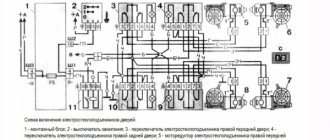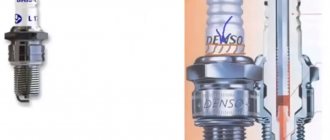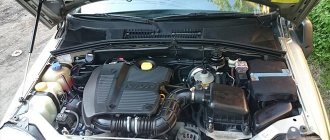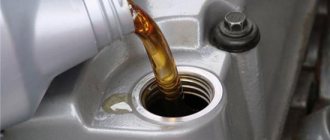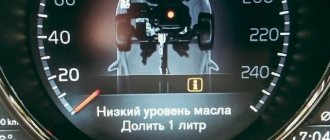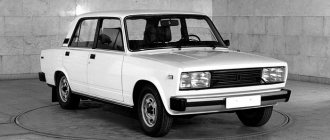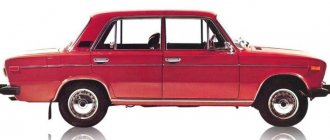Any owner will be able to fully use his car only if each of the elements of the overall mechanism works stably and without failures. Such coherence in the operation of the units will lead to the fact that all systems will be able to function extremely clearly and efficiently, thanks to which the driver will be able to enjoy control, and passengers will have the opportunity to travel comfortably. There is no point in highlighting more or less important details; the functionality of the entire mechanism depends on how harmoniously they complement each other. However, everyone knows that great importance in ensuring the owner’s ability to fully use his vehicle rests with the engine, one of the most important units of modern cars, without which not a single car can travel even a meter on its own. Despite all the abundance of companies involved in the production of engines, in this article we will together try to choose the best VAZ engine and, perhaps, after reading this material you will be pleasantly surprised by the capabilities that are included in “our” engines.
We will consider power units, which are the cause of many disputes and discussions that unfold between car enthusiasts both on the Internet - through forums, and in real life, during direct communication. So, three engines have been nominated for the title of best engine: VAZ 21116, 21126 and 21127. Which of them will be recognized as “TheBest” will be shown in our review. In fact, to understand which engine is better, you will first need to get to know them in more detail. After all, it is known that there are so many people, so many opinions, and each driver, in determining the best engine, will, first of all, be guided by personal feelings.
So which one is better?
Having familiarized ourselves with the main characteristics of our contenders, we can now safely sum up the overall results and name the winner. If you approach the question from a rational point of view, the answer to the question: “which VAZ engine is the best?” seems more than obvious - the last in the line, that is, the newest and most modified, and indeed, the VAZ 21127 engine, after all its modifications, looks like a clear favorite for the title of best, because for all its shortcomings, these are the same problems as in 21126 In case of timing belt failure and expensive maintenance, it offers very cool performance, especially for those who like to ride with the breeze. VAZ 21126 and 21127 are like brothers, however, the “twenty-seventh” is younger, but stronger, and the “twenty-sixth” is older and more confident, so to speak, that is, more significant in terms of the audience reached. Therefore, we will not even try to compare these two engines with each other, but will combine their capabilities against a common competitor - the VAZ 21116. Here we will formulate the question somewhat differently: “which engine is better, eight valve or sixteen valve?”
As an answer and, accordingly, to determine the winner, we present the following information: the main power records demonstrated by VAZ engines were achieved precisely with the help of units with 16 valves, and most importantly, when choosing a car with a 16-valve power unit, positive the owner receives more aspects than negative ones. An increase in the used volume of the fuel-air mixture, which enters the cylinders, also affects the increase in power, which is confirmed by the technical descriptions of each of the engines. In addition, changing the shape of the combustion chamber in the 16-valve engine allows it to show higher knock resistance, which is very important given the quality of the fuel that is sold at gas stations. It should also be said that in engines with 16 valves the cooling system works better, which helps to increase the reliability of the power unit. What the 8-valve unit benefits from is cheaper maintenance and, in fact, availability, since it costs less than its competitors. At one time, 8-valve power units were optimal for operation in our conditions, however, progress has made positive adjustments, allowing the engines to be modernized.
Video instructions on how to make a good VAZ engine
Model range of domestic engines
The list of Russian power units includes engines of various designs, starting with an in-line “four” and ending with a V-shaped “eight”. Let's look at a few examples of the most popular internal combustion engines:
Russian engines VAZ 11183i and VAZ 11189i
Two four-cylinder in-line engines developed for the Lada Kalina and Granta line of cars. The internal combustion engine with index 11183 has a displacement of 1.6 liters, at which its power reaches only 82 hp. With.
But the improved engine 11189, with a more economical block volume (1.4 liters), produces up to 89 horses due to the increased number of valves. Moreover, both power units meet EURO-4 requirements, which makes them available for use in Europe;
VAZ 2101-2107
A line of gasoline “fours” with in-line cylinders. It is used exclusively on VAZ “classic” passenger cars with rear wheel drive.
The working volume of such power units ranges from 1.3 to 1.6 liters, with a corresponding power spread: from 68 to 75 horsepower. In 2006, production of this type of internal combustion engine was suspended.
VAZ 2108-2115
A range of four-cylinder injection engines, with a displacement from 1.5 to 1.8 liters. The power spread of such power units is 69 – 105 hp. With. And such internal combustion engines are used only on domestic sedans, hatchbacks and station wagons.
VAZ 2121
One of the most powerful in-line “fours” of the Volzhsky plant. Its working volume is 1.8 liters, with a rated engine power of 82 hp. With. Domestic SUVs with 4X4 drive, like the Niva or Cedar, are equipped with this internal combustion engine.
Russian engines ZMZ 402.10, 420 6.10, 402 1.10 and 402 5.10
Four-cylinder engines with in-line cylinders and a displacement of 1.6 liters. They are used on low-power trucks and cars. The rated power of such internal combustion engines ranges from 95 to 100 hp. With.
ZMZ 4104.10 and 409.10
In-line “fours” with a carburetor fuel system and a displacement of 1.6 liters. Such power units are capable of producing from 96 to 143 horsepower. And they are used exclusively on all-wheel drive off-road vehicles.
ZMZ 40522.10, 4063.10, 4091.10
Injection-type engines used on cargo, passenger and utility vehicles of the middle class with carrying capacity. The block volume of such internal combustion engines reaches 1.6 liters, with a rated power of 110 to 125 liters. With. The sample with index 4063.10 also has an export version that meets EURO-4 standards.
ZMZ 4062.10 and 40621.10
In-line “fours”, with an injection power system. Most often they are used on GAZ passenger cars. But sometimes such internal combustion engines are also found on cargo-passenger UAZs. The rated power of these engines is 145 hp. s., with a volume of 1.6 liters. But their IVF level barely reaches EURO-2.
Russian engines ZMZ 40524.10 and 40525.10
Modern power units of EURO-4 standard, with four cylinders, 1.6 liters, arranged in a row. The power threshold of such internal combustion engines reaches 140 hp. pp., and they are used most often on the latest models of GAZelle and Ruta;
ZMZ 51432.10 CRS
The only turbocharged engine produced by the Zavolzhsky plant. Its power is 114 horsepower, with an engine capacity of 1.4 liters. Such an internal combustion engine can be found on domestic SUVs UAZ “Patriot”, “Hunter” and “Cargo” (including those in a pickup truck);
Domestic engines ZMZ 5233.10, 5234.10 and 513.10
V-shaped “eight” engines producing up to 130 horses. Such power units are highly specialized, since their use extends only to passenger buses and middle-class trucks.
ZMZ 73
Eight-cylinder engine, with a V-shaped arrangement of cylinders. It is used on manipulators, loaders and other special equipment of light and medium load capacity. Its working volume reaches 4.25 liters, with a maximum power of 123 hp. With.
GAZ 560 and 5601
Inline fours producing up to 95 and 110 horses, respectively. The power unit under the symbol 560 is used in passenger cars of the Sobol, Volga and Chrysler models. But a more powerful internal combustion engine is used in cargo-passenger GAZelles and Sobols.
GAZ 5621
Six-cylinder in-line engine producing up to 110 horses. Model for trucks and limited off-road SUVs “Tiger” and “Vodnik”.
GAZ 5603
Export version of the power unit that meets EURO-4 standards. It is represented by an in-line “four”, with a displacement of 1.6 liters and a rated power of 110 horsepower.
Russian engines UMZ 4215, 4216, 4216-47, 4216-4, 4216-1
Four-cylinder in-line internal combustion engines, with a power range from 96 to 107 horses. A special model for passenger cars "Gazelle" and "Sobol". Thanks to the ECO EURO-3.4 standard, such a power unit is also available for export, in versions with 8 and 16 valves.
UMZ 421
The engine has an in-line block and 4 cylinders, the working volume of which is 1.6 liters. Widely used on UAZ utility vehicles with 4X4 drive. The rated power of this internal combustion engine is 98 horsepower.
UMZ 4213
Modern power unit that meets the EURO-3 standard. Manufactured for UAZ SUVs. With a volume of 1.6 liters (4 cylinders) it produces up to 107 horses.
The average service life of domestic engines is about 150-170 thousand km for passenger cars, and from 90 to 110 thousand km for utility vehicles and SUVs with all-wheel drive.
The weight of power units produced by VAZ, GAZ, UMP and ZMZ plants does not exceed 115 kg for passenger cars, and 170 kg for heavy-duty vehicles. To power them, AI-92/95 fuel is used, and to lubricate the rubbing elements of the block, the manufacturer recommends using oil with an index from 5W30 to 15W40.
Conclusion
Therefore, to summarize and name the best VAZ engine, we give preference to the 21127 power unit, which in all respects is ahead of its competitors in this impromptu rating, but with one amendment, since its owners should be prepared for significant financial costs in the event of unexpected malfunctions . This top of the best is our subjective opinion and you may well either support it or disagree with our opinion. You can always present your arguments on this matter with reviews in the comments on the forum, share interesting photos and videos, and also offer your own options, which, in your opinion, are worthy of the title of the best VAZ engine.
Share with your friends:
Specialized Russian engines
In addition to samples for jeeps and cars, domestic engine factories also produce special-purpose engines. These include:
TMZ 864-10
V-shaped eight-cylinder diesel engine created by the Tutaevsky Motor Plant. Its maximum power is 500 hp. With. with a working volume of 17.25 liters. These types of motors are used on heavy-duty trucks.
The design of the TMZ 864-10 differs significantly from passenger combustion engines: it has a basic turbocharging and a closed crankcase ventilation system.
KAMAZ 740.74-20
300-horsepower diesel engine, with a V-shaped cylinder block. It is used on medium-class trucks with a 6X6 drive. According to the ECO standard, it meets the requirements of EURO-4. The average resource of such an internal combustion engine is 1 million km. Mileage.
YaMZ 536
Diesel power unit, with a V-shaped eight-cylinder block. Suitable for use on dump trucks and trucks with a wheelbase from 4x4 to 8x2. Occasionally used on road trains, with a total load capacity of up to 44 tons. Its displacement is 12 liters, with a rated power of 412 horsepower.
Foreign technologies are used in the design of specialized power units, such as: Common, Rail Westport and EvoTech. They allow you to reduce the fuel consumption of giants and increase their working life.
VAZ-11189
Years of production: 2015 to present.
Installed on cars: Lada Largus
This in-line 4-cylinder 1.6-liter 8-valve gasoline engine produced by AvtoVAZ is considered, if not the most reliable Russian engine, then definitely one of the most reliable. The basis for this engine was the VAZ-11186 engine, which was modified to meet new emissions standards. The only and, perhaps, main drawback of this engine was plug-in pistons, which, when the timing belt broke, bent the valves, but since 2022 this engine is equipped with plug-in pistons, and therefore new engines are no longer free of this drawback. As for the service life of the VAZ-11189 engine, according to the manufacturer’s data it is 200,000 kilometers, but in practice it is much longer.
VAZ 11189
This engine is a modernized version of the VAZ 11186 with improved exhaust quality and purity. It meets the environmental requirements of EURO 5. At the moment, this power unit is installed exclusively on the LADA Largus car.
The aluminum head with 8 valves does not have hydraulic compensators and is similar to its predecessor. The cast-iron block of in-line design is almost similar to the VAZ 21083 engine. Here, only the cooling airbag has been radically improved.
Another benefit is the strength of the timing belt, which is installed along with the automatic tensioner. Until recently, valves would bend when the belt broke. Since 2022, the manufacturer has solved this problem by changing the type of pistons.
Owners of cars with such a unit note its reliability, efficiency, excellent traction at low speeds, high maintainability, and an abundance of inexpensive spare parts.
Along with this, such motors are characterized by tripping, floating speed, internal knocking, and overheating. In addition, the engine often stalls due to a failure of the air flow sensor. Until recently, the cooling system pump often jammed.
Oil consumption
Many readers are convinced that increased oil consumption in the first thousand kilometers is nothing more than a myth. True, often such judgments are based only on personal experience, which is limited to the operation of one or, at best, several cars. Hundreds of cars, usually fresh off the assembly line, passed through the editorial office of the magazine “Behind the Wheel.” As a result, ZR experts have accumulated enormous experience in terms of operation. We have something to compare with. So, oil consumption for engines produced by VAZ, as a rule, begins to increase noticeably at 100,000 km. The reason may be oil consumption due to waste, or leaks of various engine seals. For comparison: the mileage of the editorial Lada Largus with the Renault K4M engine is already 125,000 km, and no drop in the oil level on the dipstick is observed at all.
Valve clearance adjustment interval
Some readers in the discussion of the article cited the Kia Rio and Hyundai Solaris as examples, arguing that they require valve adjustment every 30 thousand kilometers. Like, more often than with a VAZ engine. This is also not entirely true: the manual of Korean bestsellers says that a check is required once every 90,000 km. Usually it shows that you can drive up to 150,000 km. But VAZ eight-valve engines need adjustment much more often. According to the regulations - once every 45,000 km. And the experience of operating editorial cars confirms these figures. This procedure can be done less frequently only using high-quality oils and subject to regular replacement every 7,500 km.
Run-in
Many readers are sure that the VAZ engine needs running in no more than any foreign car. And this is also one of the common misconceptions among motorists today. First, let's figure out what running in is.
Run-in is carried out for the purpose of running in the mating surfaces of parts of units, components and the machine as a whole. When mutual movement occurs between microroughnesses, contact occurs, which leads to the formation of a working surface microrelief. The result of running-in is a decrease in the magnitude of friction forces and a decrease in wear of mating parts.
Thus, it is on VAZ engines that the effect of running-in is most noticeable, while in most foreign cars, running-in does not greatly affect the characteristics of the engine and, as a result, is practically invisible to the consumer.
The characteristics of VAZ engines are at the modern level
One of the readers writes: “Let’s compare the “Renova” engines installed on Largus: 16-valve K4M - 105 hp, and 8-valve K7M - 84 hp. It turns out that the VAZ versions of the Largus will be even more powerful. Are Renova engines also outdated?
Yes, the mentioned Renault engines are largely outdated. The only difference is that their design is worked out to the smallest detail and is highly reliable. These engines, except in cases where the owner made a gross error in operation, as a rule, have a significantly longer service life (about 300–400 thousand km) compared to the VAZ engine.
TOP 40 most economical cars
In particular, in this article you will find: Unfortunately, only diesel models are included in the TOP 10 of the overall rating. So if you are looking for a petrol car, go straight to the cheapest petrol cars TOP 20. Renault and Peugeot were the cheapest cars.
Of the Japanese brands, only Toyota arrived. Even the “small” Nissan Micra turned out to be too voracious: it “eats” 6.5 liters per 100 km in the combined cycle.
Rating of the most economical LADA cars (gasoline consumption)
The editors of the automobile magazine "Daily Motor" analyzed the technical characteristics of modern LADA models.
Based on this data, an assessment was compiled showing which LADA cars are the cheapest (the least fuel efficient).
Remember that the cost of servicing a car consists not only of the cost of gasoline, but also of the cost of servicing. Previously, we calculated how much one kilometer would cost for the owner of a Lada car (the calculation includes: gasoline, regular maintenance and a set of tires).
These Russian modern VAZ engines will cover 300 thousand km without capital
The domestic automotive industry is not particularly diverse in creative thought, so most cars are technically the same as their predecessors from Soviet times. However, over the course of a long time, Russian VAZ engines have been undergoing many small changes, modifications and improvements. Therefore, today there are a number of power units that are characterized by unpretentiousness, reliability and durability.
The actual resource of the list below is neither more nor less - about 300 thousand kilometers (of course, subject to operation in accordance with the manufacturer’s requirements).
Timing drive and its reliability
Many readers are convinced of the reliability and problem-free timing drive of VAZ engines. And malfunctions are attributed to unskilled car owners: someone will attach a pulley from a foreign car, someone will turn their own eccentric pulley in the wrong direction to tension the belt.
Others praise the VAZ engine for finally being equipped with non-plug pistons. At the same time, we must not forget that a huge number of previously produced motors are plug-in.
By the way, just the other day the valves of our editorial car, a Datsun mi-DO, also bent. The eight-valve engine with a displacement of 1.6 assembly line was a fiasco.
The car itself is quite new, so the belt did not collapse due to age. Moreover, the car has a hydromechanical automatic transmission, which is believed to protect the engine (compared to a manual transmission) without transferring sudden torsional loads to the crankshaft.
ZMZ-409
Years of production: 2001 to present
Installed on cars: UAZ 452, UAZ Hunter, UAZ Patriot
The in-line 4-cylinder 2.7-liter 16-valve gasoline engine ZMZ-409 can, without exaggeration, be called the best engine of all that are equipped with cars produced by the Ulyanovsk Automobile Plant (UAZ). Apart from low-quality dampers and timing chain tensioners, the condition of which must be regularly monitored, this engine does not have any significant shortcomings, and its service life is about 300,000 kilometers.
In conclusion, I note that in addition to Russian-made engines, some Lada cars are also equipped with engines from foreign manufacturers, the most reliable of which are considered to be Renault K4M and Nissan HR16DE engines.
More publications on the topic:
Did you like the post? Share!
Source
pros
- “The simpler, the better” is a popular proverb. This also applies to the 8-valve engine, a time-tested design that has only one camshaft, two valves per cylinder. There are few mechanical parts, and therefore repair and maintenance of this is much cheaper.
- Also, such a structure almost never has hydraulic compensators, which further simplifies its design. There are mechanical pushers here, which is both good and bad. Well - this mechanism is much simpler, so replacing or repairing it is also easy and cheap. By the way, these types are often equipped with stickless pistons.
- Not very picky about oil, you can fill it with semi-synthetic oils.
- It is undemanding to the quality of fuel (of course, within reason), you can safely pour 92 gasoline and not be afraid.
- Size. The upper part is much smaller, because there is only one shaft. Easier to reach attachments, generator, starter, etc.


